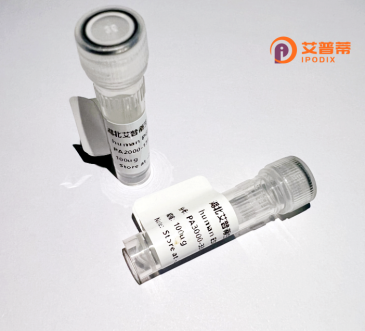
| 纯度 | >90%SDS-PAGE. |
| 种属 | Human |
| 靶点 | NDUFV1 |
| Uniprot No | P49821 |
| 内毒素 | < 0.01EU/μg |
| 表达宿主 | E.coli |
| 表达区间 | 21-464 aa |
| 活性数据 | SGDTTAPKKT SFGSLKDEDR IFTNLYGRHD WRLKGSLSRG DWYKTKEILL KGPDWILGEI KTSGLRGRGG AGFPTGLKWS FMNKPSDGRP KYLVVNADEG EPGTCKDREI LRHDPHKLLE GCLVGGRAMG ARAAYIYIRG EFYNEASNLQ VAIREAYEAG LIGKNACGSG YDFDVFVVRG AGAYICGEET ALIESIEGKQ GKPRLKPPFP ADVGVFGCPT TVANVETVAV SPTICRRGGT WFAGFGRERN SGTKLFNISG HVNHPCTVEE EMSVPLKELI EKHAGGVTGG WDNLLAVIPG GSSTPLIPKS VCETVLMDFD ALVQAQTGLG TAAVIVMDRS TDIVKAIARL IEFYKHESCG QCTPCREGVD WMNKVMARFV RGDARPAEID SLWEISKQIE GHTICALGDG AAWPVQGLIR HFRPELEERM QRFAQQHQAR QAAS |
| 分子量 | 50.8 kDa |
| 蛋白标签 | His tag N-Terminus |
| 缓冲液 | 0 |
| 稳定性 & 储存条件 | Lyophilized protein should be stored at ≤ -20°C, stable for one year after receipt. Reconstituted protein solution can be stored at 2-8°C for 2-7 days. Aliquots of reconstituted samples are stable at ≤ -20°C for 3 months. |
| 复溶 | Always centrifuge tubes before opening.Do not mix by vortex or pipetting. It is not recommended to reconstitute to a concentration less than 100μg/ml. Dissolve the lyophilized protein in distilled water. Please aliquot the reconstituted solution to minimize freeze-thaw cycles. |
以下是关于重组人(NDUFV1)蛋白研究的部分参考文献示例(部分信息可能需通过学术数据库核实):
1. **文献名称**: *NDUFV1 mutations cause mitochondrial complex I deficiency in Leigh syndrome*
**作者**: Hoefs SJ, et al.
**摘要**: 研究揭示了NDUFV1基因突变导致线粒体复合物I功能障碍,并与Leigh综合征的发病相关。通过患者细胞分析,发现突变降低复合物I活性并干扰细胞能量代谢。
2. **文献名称**: *Structural basis for malfunction in complex I assembly caused by a pathogenic mutation in NDUFV1*
**作者**: Stroud DA, et al.
**摘要**: 通过冷冻电镜技术解析了重组人NDUFV1蛋白的异常结构,发现特定突变干扰复合物I的组装过程,导致线粒体呼吸链功能障碍。
3. **文献名称**: *Recombinant NDUFV1 production in E. coli enables functional analysis of mitochondrial complex I deficiencies*
**作者**: Chang X, et al.
**摘要**: 报道了一种高效重组表达人NDUFV1蛋白的方法,并验证其在体外重建复合物I活性的功能,为相关疾病的药物筛选提供工具。
4. **文献名称**: *NDUFV1-linked ROS overproduction and neuronal apoptosis in Parkinson’s disease models*
**作者**: Zhang Y, et al.
**摘要**: 在小鼠模型中,NDUFV1功能缺陷导致活性氧(ROS)累积,引发多巴胺能神经元凋亡,提示其在帕金森病中的潜在作用机制。
建议通过PubMed或Google Scholar以“NDUFV1 recombinant protein”“complex I deficiency”等关键词检索最新文献。
NDUFV1 (NADH:ubiquinone oxidoreductase core subunit V1) is a critical nuclear-encoded component of mitochondrial Complex I (CI), the largest enzyme in the electron transport chain (ETC) responsible for oxidizing NADH and transferring electrons to ubiquinone. This 51 kDa protein forms part of the flavoprotein subcomplex within CI’s N-module, harboring a flavin mononucleotide (FMN) cofactor essential for catalytic activity. NDUFV1 plays a pivotal role in CI assembly and function, influencing proton translocation and ATP synthesis. Mutations in the NDUFV1 gene are linked to mitochondrial disorders, including Leigh syndrome, and neurodegenerative conditions like Parkinson’s disease, often associated with CI deficiency and oxidative stress.
Recombinant human NDUFV1 protein is engineered using expression systems (e.g., E. coli, mammalian cells) to study its structure-function relationships, pathogenic variants, and interactions within CI. Its production enables biochemical assays, antibody development, and drug screening for mitochondrial diseases. However, challenges persist in maintaining the protein’s native conformation due to its hydrophobic domains and dependence on partner subunits for stability. Current research focuses on leveraging recombinant NDUFV1 to elucidate CI dysfunction mechanisms and explore therapeutic strategies, including gene therapy and small-molecule chaperones. Its study remains vital for understanding metabolic regulation and mitochondrial pathologies.
×